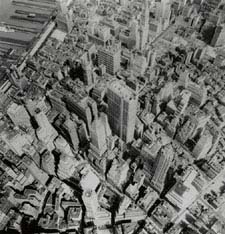
CLICK IMAGE TO ENLARGE
|
A Modern Downtown
Downtown's other major problem was the exodus of corporate headquarters and jobs to midtown and beyond. Statistically, Lower Manhattan held its status as the nationís largest central business district through the mid-1940s, but in the 1950s and '60s, an array of signature glass towers on Park Avenue and Avenue of the Americas established the International Style and the "tower in the plaza" as the image of modernity and corporate success.
Except for the elegant new headquarters of Chase Manhattan Bank, completed in 1961, downtown's dignified but aging office stock consisted primarily of buildings erected from the 1900-1930s, built before air conditioning and fluorescent lighting. In the congested but still prime core around Wall Street, construction was exceptionally complex and expensive. Plans for new office development therefore focused on the low-rise buildings at the edges of the historic core and on the waterfront where buildings were low-rise and of lower valuation. The targeted expansion districts were the World Trade Center, developed by The Port of New York Authority, and a newly widened Water Street, where private investment financed big, bulky towers with zoning bonuses and other incentives from the City.
Image Credit and Description:
Thomas Airviews, Lower Manhattan
Aerial view of Wall Street and financial district
May 18, 1960
Silver-gelatin print, 8 x 10 in.
Collection of The New-York Historical Society
The extraordinary density of skyscrapers and narrowness of streets in the historic core of the financial district are especially clear in this photograph, which features at the center the new 60-story headquarters of Chase Manhattan Bank before its spacious plaza was completed. |